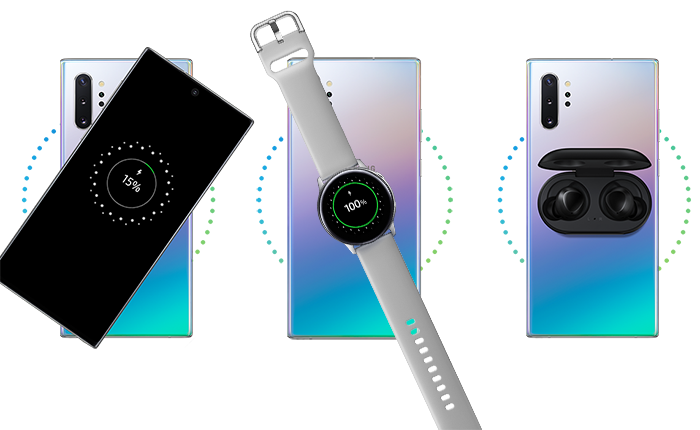Some smartphones have wireless charging, but few are those which are capable to reverse charge other devices.
Well, Samsung has had this technology on their phones for some time now, and they call it Wireless PowerShare.
Let us explain.
What is PowerShare?
In principle it is a reverse wireless charging technology, an innovative feature, which enables you to turn your device into a portable power station.
Samsung had introduced it with their S10 models and kept it on their top notch smartphones, namely the S, Z and Note series, as listed further down in this article for your information.
PowerShare works with devices such as smartphones, but also other accessories like earbuds and smartwatches which have a Qi technology, a common industry standard for wireless charging.
Qi pronounced as Chee coming from the Chinese word, is a typical open interface that defines wireless power transfer using inductive charging over distances of up to 4cm or 1.6 inches. It is developed by the Wireless Power Consortium.
Which Samsung smartphones have PowerShare?
As aforementioned, not all Samsung smartphones hold PowerShare, but it is restricted to their recent top tier line of devices. Here is the list so far:
- Samsung Galaxy S10 series
- Samsung Galaxy Note10 series
- Samsung Galaxy S20 series (including the S20 FE)
- Samsung Galaxy Note20 series
- Samsung Galaxy Z Flip and Z Flip 3
- Samsung Galaxy Z Fold, Z Fold 2, and Z Fold 3
- Samsung Galaxy S21 series (including the S21 FE)
- Samsung Galaxy S22 series
So, only Samsung provides reverse wireless charging?
Apart from Samsung there are other smartphones who have reverse wireless charging under the hood, like the OnePlus 10 Pro or the Google Pixel 6 Pro, to name two.
However, on those devices it is just called as reverse wireless charging, not Wireless PowerShare, with the latter title pertaining to Samsung only.
How to use Samsung Wireless PowerShare
The method is rather simple, whether you want to reverse charge another smartphone, pair of earbuds or smartwatch, all you have to do is to enable PowerShare as follows:
- Settings
- Navigate to Battery and Device Care
- Select Battery
- Tap Wireless Power Sharing
- Toggle the button to enable the option from off to on
Alternatively, you can enable Wireless PowerShare more swiftly by swiping down from the top of your smartphone`s display to open the notification panel and choose it from there.
Once PowerShare is enabled, put the smartphone face down, and place the secondary smartphone or accessories which need to be charged centrally on the back of the main smartphone on which reverse wireless charging has been enabled.
You should see a light on the earbuds case or the smartwatch showing that they are being charged, while on a smartphone there will be the usual message or charging pattern.
Note that devices need to be placed centrally and aligned for the reverse wireless charging or PowerShare to kick into action, since the charging coils are embedded centrally at the back of the smartphones, earbuds` cases or smartwatches.
If the other device isn`t charging, check the alignment of both, readjust placement so that charging coils are lined up. You may also need to remove any smartphones` external silicone or plastic cases for a successful charging experience, thus reducing disruption, and allowing the reverse wireless charging to function properly.
Is Wireless PowerShare Fast?
Now, although it is fascinating to have a device capable to reverse charge wirelessly, it isn`t fast by any means. Samsung`s own PowerShare in fact can output up to 4.5W of power, however when considering that no cables are being used with reverse wireless charging, the other devices will be charged slowly.
PowerShare will come handy or is ideal to slightly top up earbuds or smartwatches say while travelling, replacing power banks if forgotten or drained. Thus, charging with cables will always be faster.
PowerShare will deplete my battery?
Keep in mind that power loss from the PowerShare enabled smartphone does not equate to the power given to the secondary device, since during reverse wireless charging the electricity or charge will be disrupted by passing through the smartphone`s glass rear cover and the secondary device`s casing, which may be plastic or glass.
These insulating materials will dampen the flow of electrons, making the entire process inefficient and wasting your precious battery juice.
If this is of concern to you, charge the main smartphone with a cable while using it as a reverse wireless charging power bank at the same time. However, this way it will top up the secondary device at a slower pace.
It is worth noting that reverse wireless charging will stop when your phone`s battery drops to a certain level. Moreover, you can set this threshold from the Settings app, and you get to choose anywhere from 30% to 90%.
But is PowerShare bad for my battery then?
Well, it all bores down on how you use it.
If reverse wireless charging is utilised sparsely, to top slightly wearables like a smartwatch or the earbuds` case, then there is no major concern, but if used regularly it will have a hit on your smartphone`s battery lifespan in the long run.
During PowerShare the smartphone will get warm, as it generates a lot of heat, which is one of the major causes of battery wear.
Final thoughts
Samsung`s Wireless PowerShare is a convenient feature which enables you to reverse charge wirelessly other devices on the go, replacing drained power banks or the lack of.
It is recommended to be used as it was meant to, thus reducing the possibility of battery depletion or avoid affecting its lifespan.
PowerShare is not practical for frequent use, especially due to the highly disproportionate battery drain. So, you are better off using cables being chargers or power banks when available for everyday scenarios, and limiting PowerShare to emergencies or travelling as it was meant for.

